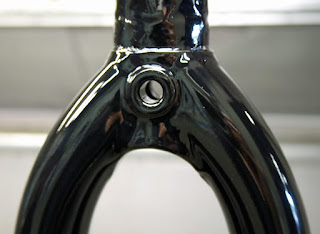Increasingly superseded by
stainless, chrome has long been synonymous with Italian manufacturers, despite Columbus recommending their tubesets were not subjected to acid baths,
filing and similar torture...
Scapin are an Italian
marque, renown for coating their steel frames internally with phosphate and nickel
plating the exterior tubes. Allegedly, this was also for corrosion resistance,
though I remain convinced aesthetics were the biggest pull. This particular
example came under my radar, while I was mooching around Maldon Shot Blasting
& Powder Coating’s bat-cave.
Closer inspection suggests
it was fashioned from Columbus’ thin wall Nemo or Genius tubing. I strongly
suspect it was originally part-painted like this Rossin but chemically stripped
once the livery had begun losing its tenure and/or succumbing to stone chips
and other cosmetic damage.
Persuading stove enamel and 2pac
finishes to stay put on partially/ plated framesets has presented headaches a
plenty for paint-shops. Acid etch primers ruled by default but given a few
years’, the livery tends to flake and peel where the two overlap.
This customer has chosen to
leave the rear triangle in its original polished state. Aesthetics aside, this
means chain slap and hasty wheel removals won’t leave unsightly calling cards.
Graham carefully mummifies these with masking tape to rule out any pitting from
blast media.
Having passed the threaded
uni-crown forks through the iron oxide cabinet, Graham decides to sand the main
triangle. He fears even a gentle grit could lift the nickel in places, which is
not something that can be disguised with additional paint.
Instead, he opts for
an epoxy based zinc primer. Epoxy offers superior adhesion and interestingly,
resists chemical attack better than others. However, they aren’t UV stable;
hence polyester powder is the good finisher’s choice for colour coats.
After meticulous plugging
and masking of head, seat tube and threaded areas, the frameset disappears
beneath a powdery grey mist. Seven minutes and some perfectionist re-touching
later, its spirited off for a ten minute bake in their gas oven.
Monitoring progress around
the seven minute mark, the powder has melted to a rich (and strangely
attractive) grey skin. Next; Graham applies a gloss black, a common “colour”
that including lacquer brings the price to £65 plus VAT. However, this is only
the base for a very exotic commission.
Four minutes and some
localised re-touching later, its back to the curing oven for another ten minute
bake; I alter the camera settings slightly and sip some tea, while Graham
heaves a huge box of powder across the workshop dung beetle fashion. “Sapphire
Star clear coat” he shouts over.
I’m told this acrylic is impregnated with tiny
pigments of colour. The overall effect is timeless petrol blue under normal lighting
but assumes a subtle sparkle on sunny days. It’s well known that colours have slightly unique characteristics, requiring different techniques but Graham explains; particular care is needed with
this kind of specialist clear coats-including temperature.
The Scapin must
not be allowed to cool, otherwise crazing or clouding is on the cards-disastrous.
Gun loaded with lacquer, he strides purposefully over to the oven, caresses the
frame tubes, nods with a grin and retrieves the frameset.
Powder lacquers always
appear white, enabling the sprayer to see exactly where they’ve been. Anything
other than exacting coverage here will ruin the effect but like any skilled
trade, he makes this look effortless-done in five minutes.
Back to the oven for another ten minutes, we’ve time to indulge in a biscuit; or three. Graham removes the masking tape while the adhesive is still soft and I get a final shot.
Back to the oven for another ten minutes, we’ve time to indulge in a biscuit; or three. Graham removes the masking tape while the adhesive is still soft and I get a final shot.
Total cost is £162 including
VAT.











